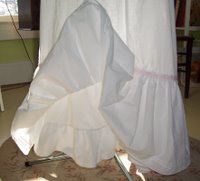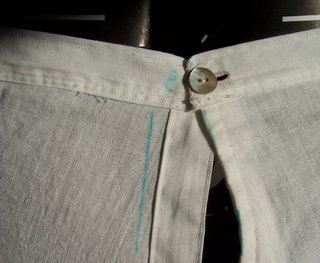 It's done! A muslin petticoat made in 1911 style with a double flounce! I decorated the outer flounce with tiny tucks and lace insertion, threaded with pink ribbon.
It's done! A muslin petticoat made in 1911 style with a double flounce! I decorated the outer flounce with tiny tucks and lace insertion, threaded with pink ribbon. The petticoat was sewn primarily on a Willcox and Gibbs treadle sewing machine, and the garment's construction features the incredibly narrow, precise machined hems that the Willcox and Gibbs hemming attachments make possible, plus the equally precise tucks.
This marked the first time I'd used these attachments, and they clear up the mystery of how finely sewn many antique garments are. Old machines such as the W&G make that sort of work quite straightforward.
I used a Singer 27 VS handcrank machine to produce small gathers at the waistband and on the flounces. Only the finish on the waistband lap is handsewn.
I drafted and constructed the petticoat following instructions from Textbook on Domestic Art, 1911. You can too! Previous posts on this blog tell more about the textbook and how to find it on the Cornell HEARTH site.
Additional Views
The petticoat is triple-tucked. The hem on bottom is 1/8 of an inch wide, and is a double hem, that is, the raw edge is turned to the back of the garment, then turned under again to fully hide it.
The Willcox and Gibbs attachment did that in one smooth motion , which left me rather amazed. I can't get as clean a hem on my electric machine.
, which left me rather amazed. I can't get as clean a hem on my electric machine.

 , which left me rather amazed. I can't get as clean a hem on my electric machine.
, which left me rather amazed. I can't get as clean a hem on my electric machine.

The garment has two flounces. That means extra volume when you wear it. The lower flounce starts about shin height, which means the skirt fluffs at your feet when you walk, but leaves your knees unencumbered, and is cooler generally.


Closeup of the placket. It's a bit hard to see, but the stitches are tiny: chainstitchers like the Willcox and Gibbs generally make incredibly small stitches. Second, between one stitch and the next, the line is very straight. The stitch guide helps, and the precision of the cast-iron parts that drive the machine, but it may be the needle that has the most effect.
I didn't know this until a few weeks ago, but the standard needles many people use on electric machines are ballpoint...that is, they're not too sharp. When the machine makes a stitch, the ballpoint edge slides into the next available hole in the weave.
The commercial Schmetz needle I am using, by contrast, has a very sharp point, so the needle goes right through the woven threads, not between them. Eh voila, each stitch follows the next perfectly straight, not in a slightly offset pattern. And I thought it was my skills:} Oh well.


And last, a side view of the petticoat. Behind it you can just see the Willcox and Gibbs. Yes, that is one very small machine.

4 comments:
The petticoat is very beautiful! Thanks for posting such clear information about your research and the creation process, and tagging it so it was easy to find. This will be really helpful when I get going on my 1912 clothing. I suspect I will be linking to your posts on a lot of mine! :)
Dear Ava,
Super!! It was a dream to make. Say, will your 1912 clothing have much swish at the hem? That petticoat was made for 1911 wear, which had quite a hem circumference. A year later they were building very narrow, unflounced models. See for example my blog on an extant in my collection, at http://zipzipinkspot.blogspot.com/2005/11/anatomy-of-real-vintage-petticoat_08.html.
Very best,
Natalie
I don't know yet. I'm still doing pretty general clothing research for the period; I need to get into newspapers and photographs of a local nature to determine how fast fashion changes made it all the way to rural New Mexico. It wouldn't be terribly surprising if things were a bit behind! Plus, the statehood signing took place at the very beginning of the year, so it will also depend on *how* specific I want to be with the timeline. I find that I tend to prefer the swishier, slightly less columnar styles of 1910-11, so that may also lean me in that direction if it seems historically up in the air.
I was reading about your extant petticoat earlier - it's very helpful to see all the details. I've been reading through a lot of your Edwardian clothing posts, and resisting the urge to leave a barrage of excited comments. :D
Dear Ava,
Oh good, you're getting into the nitty-gritty. This is going to be very exciting. Perhaps there are some local photo archives that will offer details of what was on folks' backs at the year's beginning.
Can't wait to hear more. So glad you are finding the posts useful. You will see growth and change and learning there, for sure...I was really confused on the belting thing for awhile.
Very best, and now offline to some embroidery before bedtime,
Natalie
Post a Comment